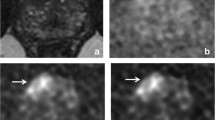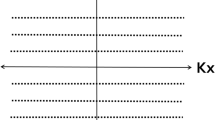Abstract
Improvements in SNR due to use of 3T magnets are a potential advantage for DWI, although the parallel increase of artifact is difficult to eliminate. This chapter gathers the effect of the magnetic field strength in the DWI acquisition. Advanced clinical applications of DWI in body studies are clearly benefit for the use of high-field strength magnets. Clinical examples of DTI in prostate, heart, muscle or kidney, DWI neurography, or IVIM model are presented. Radiologist should be aware of this potential source of error when reading DWI sequences. In this sense, different pitfalls on DWI are introduced, such as T2 shine-through and dark-through, the effect of metal implants and iron overload, restriction of normal structures, nonmalignant lesions with apparent restriction of free water movement, and the appearance of low-grade tumor on DWI.
Access this chapter
Tax calculation will be finalised at checkout
Purchases are for personal use only
Similar content being viewed by others
Further Reading
Balbi V, Budzik JF, Duhamel A et al (2011) Tractography of lumbar nerve roots: initial results. Eur Radiol 21(6):1153–1159
Bernstein MA, Huston J III, Ward HA (2006) Imaging artifacts at 3.0 T. J Magn Reson Imaging 24(4):735–746
Chandarana H, Lee VS, Hecht E et al (2011) Comparison of biexponential and monoexponential model of diffusion weighted imaging in evaluation of renal lesions: preliminary experience. Invest Radiol 46(5):285–291
Deux JF, Malzy P, Paragios N et al (2008) Assessment of calf muscle contraction by diffusion tensor imaging. Eur Radiol 18(10):2303–2310
Eguchi Y, Ohtori S, Yamashita M et al (2011) Diffusion weighted magnetic resonance imaging of symptomatic nerve root of patients with lumbar disk herniation. Neuroradiology 53(9):633–641
Feuerlein S, Pauls S, Juchems MS et al (2009) Pitfalls in abdominal diffusion-weighted imaging: how predictive is restricted water diffusion for malignancy. Am J Roentgenol 193(4):1070–1076
Filler AG, Haynes J, Jordan SE et al (2005) Sciatica of nondisc origin and piriformis syndrome: diagnosis by magnetic resonance neurography and interventional magnetic resonance imaging with outcome study of resulting treatment. J Neurosurg Spine 2:99–115
Fitts RH, McDonald KS, Schluter JM (1991) The determinants of skeletal muscle force and power: their adaptability with changes in activity pattern. J Biomech 24(Suppl 1):111–122
Galban CJ, Maderwald S, Uffmann K et al (2005) A diffusion tensor imaging analysis of gender differences in water diffusivity within human skeletal muscle. NMR Biomed 18(8):489–498
Gibbs P, Pickles MD, Turnbull LW (2006) Diffusion imaging of the prostate at 3.0 tesla. Invest Radiol 41(2):185–188
Grünberg K, Grenacher L, Klauß M (2011) Diffusion-weighted imaging of the pancreas. Radiologe 51(3):186–194
Gurses B, Tasdelen N, Yencilek F et al (2011) Diagnostic utility of DTI in prostate cancer. Eur J Radiol 79(2):172–176
Hiwatashi A, Kinoshita T, Moritani T et al (2003) Hypointensity on diffusion-weighted MRI of the brain related to T2 shortening and susceptibility effects. Am J Roentgenol 181(6):1705–1709
Holl N, Echaniz-Laguna A, Bierry G et al (2008) Diffusion-weighted MRI of denervated muscle: a clinical and experimental study. Skeletal Radiol 37(12):1111–1117
Kakuda T, Fukuda H, Tanitame K et al (2011) Diffusion tensor imaging of peripheral nerve in patients with chronic inflammatory demyelinating polyradiculoneuropathy: a feasibility study. Neuroradiology. Feb 12 [Epub ahead of print]
Kan JH, Heemskerk AM, Ding Z et al (2009) DTI-based muscle fiber tracking of the quadriceps mechanism in lateral patellar dislocation. J Magn Reson Imaging 29(3):663–670
Khalil C, Budzik JF, Kermarrec E et al (2010) Tractography of peripheral nerves and skeletal muscles. Eur J Radiol 76(3):391–397
Kim CK, Park BK, Han JJ et al (2007) Diffusion-weighted imaging of the prostate at 3 T for differentiation of malignant and benign tissue in transition and peripheral zones: preliminary results. J Comput Assist Tomogr 31:449–454
Klauss M, Lemke A, Grünberg K et al (2011) Intravoxel incoherent motion MRI for the differentiation between mass forming chronic pancreatitis and pancreatic carcinoma. Invest Radiol 46(1):57–63
Kuhl CK, Textor J, Gieseke J et al (2005) Acute and subacute ischemic stroke at high-field-strength (3.0-T) diffusion-weighted MR imaging: intraindividual comparative study. Radiology 234:509–516
Kwee TC, Takahara T, Ochiai R et al (2008) Diffusion-weighted whole-body imaging with background body signal suppression (DWIBS): features and potential applications in oncology. Eur Radiol 18:1937–1952
Lewin JS, Duerk JL, Jain VR et al (1996) Needle localization in MR-guided biopsy and aspiration: effects of field strength, sequence design, and magnetic field orientation. Am J Roentgenol 166(6):1337–1345
Lewis AM, Layzer R, Engstrom JW et al (2006) Magnetic resonance neurography in extraspinal sciatica. Arch Neurol 63(10):1469–1472
Luna A, Sánchez-Gonzalez J, Caro P (2011) Diffusion-weighted imaging of the chest. Magn Reson Imaging Clin N Am 19(1):69–94
Manenti G, Carlani M, Mancino S et al (2007) Diffusion tensor magnetic resonance imaging of prostate cancer. Invest Radiol 42(6):412–419
McVeigh PZ, Syed AM, Milosevic M et al (2008) Diffusion-weighted MRI in cervical cancer. Eur Radiol 18:1058–1064
Merkle EM, Dale BM (2006) Abdominal MRI at 3.0 T: the basics revisited. Am J Roentgenol 186(6):1524–1532
Morisaki S, Kawai Y, Umeda M et al (2011) In vivo assessment of peripheral nerve regeneration by diffusion tensor imaging. J Magn Reson Imaging 33(3):535–542
Murtz P, Krautmacher C, Traber F et al (2007) Diffusion-weighted whole-body MR imaging with background body signal suppression: a feasibility study at 3.0 Tesla. Eur Radiol 17:3031–3037
Notohamiprodjo M, Dietrich O, Horger W et al (2010) Diffusion tensor imaging (DTI) of the kidney at 3 tesla-feasibility, protocol evaluation and comparison to 1.5 tesla. Investig Radiol 45(5):245–254
Okamoto Y, Kunimatsu A, Miki S, Shindo M, Niitsu M, Minami M (2008) Fractional anisotropy values of calf muscles in normative state after exercise: preliminary results. Magn Reson Med Sci 7(3):157–162
Petchprapa CN, Rosenberg ZS, Sconfienza LM et al (2010) MR imaging of entrapment neuropathies of the lower extremity. Part 1. The pelvis and hip. Radiographics 30(4):983–1000
Qayyum A (2009) Diffusion-weighted imaging in the abdomen and pelvis: concepts and applications. Radiographics 29(6):1797–1810
Reischauer C, Wilm BJ, Froehlich JM et al (2010) High-resolution diffusion tensor imaging of prostate cancer using a reduced FOV technique. Eur J Radiol. Jul 15 [Epub ahead of print]
Schenck JF (1996) The role of magnetic susceptibility in magnetic resonance imaging: MRI magnetic compatibility of the first and second kinds. Med Phys 23(6):815–850
Takahara T, Hendrikse J, Yamashita T et al (2008) Diffusion-weighted MR neurography of the brachial plexus: feasibility study. Radiology 249(2):653–660
Takahara T, Hendrikse J, Kwee TC et al (2010) Diffusion-weighted MR neurography of the sacral plexus with unidirectional motion probing gradients. Eur Radiol 20(5):1221–1226
Takahara T, Kwee TC, Hendrikse J et al (2011) Subtraction of unidirectionally encoded images for suppression of heavily isotropic objects (SUSHI) for selective visualization of peripheral nerves. Neuroradiology 53(2):109–116
Tamai K, Koyama T, Saga T et al (2007) Diffusion-weighted MR imaging of uterine endometrial cancer. J Magn Reson Imaging 26(3):682–687
Vargas MI, Viallon M, Nguyen D et al (2010) New approaches in imaging of the brachial plexus. Eur J Radiol 74(2):403–410
Wang J, Yu T, Bai R et al (2010) The value of the apparent diffusion coefficient in differentiating stage IA endometrial carcinoma from normal endometrium and benign diseases of the endometrium: initial study at 3-T magnetic resonance scanner. J Comput Assist Tomogr 34(3):332–337
Whittaker CS, Coady A, Culver L et al (2009) Diffusion-weighted MR imaging of female pelvic tumors: a pictorial review. Radiographics 29(3):759–774
Zandieh S, Berna R, Steinbach S et al (2011) The optimal B value in diffusion-weighted magnetic resonance neurography of the brachial plexus. Internet J Radiol 13(1)
Zaraiskaya T, Kumbhare D, Noseworthy MD (2006) Diffusion tensor imaging in evaluation of human skeletal muscle injury. J Magn Reson Imaging 24(2):402–408
Author information
Authors and Affiliations
Corresponding author
Rights and permissions
Copyright information
© 2012 Springer-Verlag Berlin Heidelberg
About this chapter
Cite this chapter
Sánchez-González, J., Luna, A. (2012). DWI at 3 T: Advantages, Disadvantages, Pitfalls, and Advanced Clinical Applications. In: Diffusion MRI Outside the Brain. Springer, Berlin, Heidelberg. https://doi.org/10.1007/978-3-642-21052-5_4
Download citation
DOI: https://doi.org/10.1007/978-3-642-21052-5_4
Published:
Publisher Name: Springer, Berlin, Heidelberg
Print ISBN: 978-3-642-21051-8
Online ISBN: 978-3-642-21052-5
eBook Packages: MedicineMedicine (R0)




